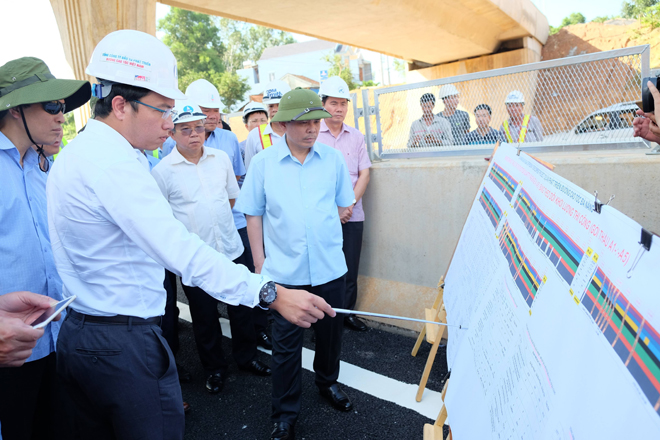Entire Da Nang-Quang Ngai Expressway ready for traffic
After its failure to meet the original scheduled deadline, the whole large-scale Da Nang-Quang Ngai Expressway project is ready for opening to traffic on 2 September to mark the upcoming 73rd National Day.
 |
| Transport Minister Nguyen Van The (wearing a green sun-helmet) during his early August inspection visit to the Da Nang-Quang Ngai Expressway project site |
The first part of the expressway, the 65km-long section between Da Nang’s Tuy Loan Village and Quang Nam Province’s Tam Ky City, was opened to traffic in August 2017, and it has proved highly effective.
Meanwhile, the second part which links Tam Ky City with Quang Ngai Province is now nearing completion, ready for use.
Viet Nam Expressway Corporation (VEC), the project’s developer, has pledged that the remaining main work items, including grated-opening drain systems, crossings, frontages roads and traffic safety signboards along the Tam Ky-Quang Ngai section, would be completed prior to the opening date of the expressway.
The project completion deadline has been pushed back for 2 times to date.
In detail, on 13 April, Deputy Minister of Transport Le Dinh Tho asked the project’s developer to meet a completion deadline of 30 June, but still worse, the project was then pushed back to 31 July.
The main reason for the work being behind schedule was that the construction units faced some difficulties arising during the work, including the building of frontage roads, and the compensation work for affected families whose houses were partly cracked by the construction work.
In particular, one of the work items still under construction is the establishment of traffic barriers along the whole route.
 |
| As part of the whole expressway, a section which links Tam Ky City with Quang Ngai Province now nearing completion, ready for use. |
After having conducted a recent inspection of the project, the State Council for Pre-Acceptance Test of Construction Works remarked that the expressway totally meets technical quality requirements, and construction work has been put under strict supervision.
The deployment of the large-scale expressway project, the first of its kind in the central region, is part of the country’s expressway network development plans by 2020, with a vision towards 2030.
Stretching nearly 140km and linking with the National Highway No 1, the expressway runs through Da Nang, and Quang Nam and Quang Ngai provinces.
Work started on the 6-lane route in May 2013 at a total estimated cost of over 1.6 billion USD.
Of this, 798.5 million USD in loans is offered by the Japan International Cooperation Agency (JICA), whilst 590.3 million USD is lent by the World Bank (WB), and the remainder come from the national budget.
The highway allows speed limits of up to 120km per hour, which helps reduce travel time from Da Nang to Quang Ngai to one hour and a half instead of the usual 3 hours using the National Highway No 1.
Once operational, besides helping relieve traffic pressure on the National Highway No1, the soon-to-be-opened route will form part of Viet Nam’s north-south expressway. It will play an important role in accelerating the development of the central region’s economic hub, as well as strengthening the links between Da Nang and the provinces of Quang Nam and Quang Ngai.
In addition, thanks to the soon-to-be-opened route, the socio-economic development of the 3 localities it runs through will be boosted, their security and defence will be ensured, and the living conditions of their local residents will be enhanced.
Of note, the project will also enhance international transport links between Laos, Cambodia, and Viet Nam, through the East-West Corridor, to a number of seaports in Central Viet Nam.




